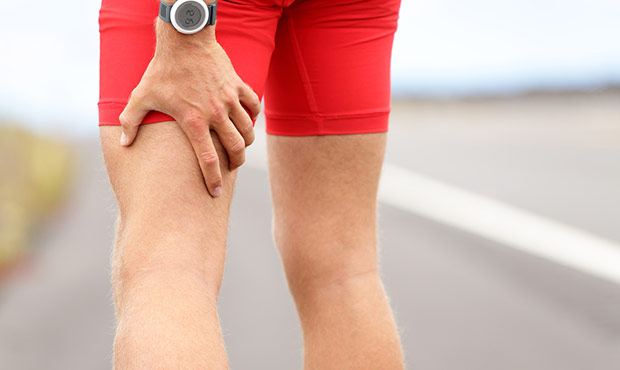
The hamstring plays a pivotal role in walking, jumping, running, cycling and swimming. The hamstrings are the powerhouse of your legs. They allow you to bend your knees, straighten your leg and control movement from the hip. A hamstring injury can cause a big disruption in your fitness or training regimen, leaving you on the couch for weeks if not treated right.
What is a Hamstring Strain?
A hamstring strain is an excessive stretch or tear to the muscle fibers. Hamstring strains are caused by overloading, often due to inadequate warm-ups, overuse, or weak glutes.
What Are the Symptoms?
- Sharp pain in the back of the leg during exercise
- Swelling or bruising
- Pain when stretching or contracting the muscle
Severity of a Hamstring Pull
Grade 1
- Discomfort when walking
- Tightness in posterior thigh
- Minor swelling
- Slight pain when bending the knee against resistance
Grade 2
- Difficulty when walking—slight limp
- Pain during activity
- Noticeable swelling or bruising
- Pain when bending the knee against resistance—very difficult
- Unable to straighten the knee
Grade 3
- Severe pain
- Major swelling or bruising
- Difficulty walking—may need crutches
- Can't bend or straighten the knee
Hamstring Strain Treatment
Once you experience any of the symptoms above, you should immediately stop your exercise. Apply ice to the injury and continue with R.I.C.E. therapy (Rest, Ice, Compression, Elevate). If bruising occurs—the result of internal muscle bleeding—use a compression bandage on the hamstring to minimize bruising. During the first few days, ice your hamstring with your leg straight. This will help control the swelling and gently stretch the muscle. Heat should not be applied until the third or fourth day. Heat may increase swelling or muscle bleeding. Use the compression bandage instead.
Gentle stretching and light resistance will also help recover your hamstring muscle. Here are some effective treatment options you can try at home.
Hamstring Stretch
- Find a wall, pole or doorway.
- Lay on the floor facing up.
- Bring the injured leg straight up and rest it against the wall.
- Your healthy leg is either bent (if using a wall) or straight on the ground if using a doorway or pole. As you gain strength, you can move closer to the wall, pole or doorway.
Hamstring Strengthener Exercise
- Sit on a chair or stool with wheels.
- Bend both legs.
- Take the injured leg and straighten it out in front of you with your heel staying on the ground.
- Slowly bend the knee of the injured leg so the chair starts to move forward.
- Then repeat the movement.
- Try to move the chair from one side of the room to the other.
If pain occurs longer than two weeks, you should seek medical help.
Rest
Injuries take time to heal. While it is difficult to put training and running on pause, resting your leg will help speed up recovery. Try to avoid putting your full weight on the leg. If pain is severe, consider crutches until it goes away. Consult your doctor or physical therapist if you’re unsure whether crutches are necessary.
Reduce Swelling
To reduce swelling and minimize pain, ice the area for 20 to 30 minutes every three to four hours for the first few days, or until pain is gone. Also, elevate your leg when sitting or laying down.
Consider taking anti-inflammatory medication to reduce pain and swelling. Compression can also help reduce swelling. Use an elastic bandage to compress the area.
Hamstring Strain Prevention
Strengthening your hamstrings and glutes is the best way to prevent a hamstring strain. Try to add strength exercises to your routine in addition to your cardio training.
Be sure to stretch before and after each workout to loosen up your muscles. Consider consulting a physical therapist for strengthening exercises if strains are recurring.
In some cases, the muscle may tear and require surgery. Consult a doctor if pain is severe and isn’t going away.
Read This Next: 16 Quick Post-Workout Stretches to Prevent Injury
Hamstring Strain FAQs
How long does it take to recover from a hamstring strain?
A moderate hamstring strain will typically heal within three to eight weeks with rest and recovery. For a more serious strain, full recovery may take up to three months.
Is walking with a hamstring strain okay?
It is important to rest when you are experiencing sharp pain. However, as pain starts to subside, incorporating mild exercises like walking and cycling is beneficial.
Should you foam roll a hamstring strain?
No. Using a foam roller within the first week of injury can worsen the issue. Ice, rest, and elevation are important during the acute phase of healing. After initial recovery, mild exercise, stretching, and a sports massage can help.
Fitness Events Near You
Connect with us on Twitter, Facebook, Instagram or Pinterest for more tips, recipes and ideas to fuel your ACTIVE life.
 Stay in shape in a fitness class or read more fitness articles.
Stay in shape in a fitness class or read more fitness articles.


